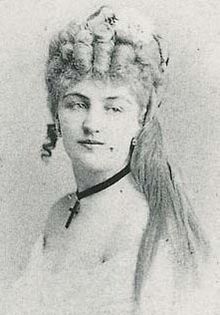Méry Laurent
Méry Laurent (actually Anne-Rose Louviot) (born April 29, 1849 in Nancy ; † November 26, 1900 in Paris ) was a well-known cocotte and muse of various artists in Paris at the end of the 19th century .
Life
At the age of 15 Anne-Rose Louviot married a spice dealer, but divorced after a few months. She then went to Paris and began a less successful acting career under the name Méry Laurent. In addition to a few extras, she appeared in revues with little clothing. For example, she appeared almost naked in the play La belle Hèlene during the Paris World's Fair in 1867 . After such an appearance, when she emerged naked from a shell, she met the old General de Canrobert and became his lover.
Méry Laurent later met the rich American Thomas W. Evans , who was the dentist of the imperial family Napoléon III. had been and also treated the tsarist family. Evans entered into a permanent liaison with Méry Laurent and paid her 50,000 francs a year. He also furnished her with an apartment on Rue de Rome and bought her the Villa de Talus on Boulevard Lannes.
Now financially secure, Méry Laurent began a series of liaisons with well-known artists of her time, parallel to the relationship with Evans. The poet François Coppée started. It was followed in 1876 by the painter Édouard Manet , who not only wrote her tender letters, but also painted her several times. In addition to the autumn oil painting ( Musée des Beaux-Arts de Nancy ), Manet created a series of pastel paintings by Méry Laurent. These include Méry Laurent with a black hat ( Musée des Beaux-Arts (Dijon) ), Méry Laurent with a dog ( Pushkin Museum ), Méry Laurent with a veil (private collection), Méry Laurent with otter fur (private collection), Méry Laurent with a hat decorated with flowers ( Hiroshima Museum of Art ) or Mery Laurent with a small hat ( Sterling and Francine Clark Art Institute ). Through her mediation, Manet managed to sell some of his pictures, and she herself also built up a small collection of paintings of Manet's works. She was also an early collector of Gauguin's works .
Through Manet, she met the poet Stéphane Mallarmé , who also fell in love with her, although Huysmans claimed that they had never had a sexual affair. Méry Laurent inspired Mallarmé to write poems, and later his letters to Méry were also published.
She also met Marcel Proust through Mallarmé . Her last affectionate friend became the young musician Reynaldo Hahn , whom she also appointed executor.
reception
Stéphane Mallarmé about Méry Laurent:
| Ouverte au rire qui l'arrose | Open to laughter and tender |
| Telle sans que rien d'amery | She is blushing without any bitterness. |
| Séjourne, une embaumante rose | Blooming like a rose in the garden |
| You jardin royal est Méry. | of the king, this is Méry. |
The Irish writer George Moore called Méry Laurent a "tea rose".
Marcel Proust took its dazzling appearance in his novel In Search of Lost Time as a template for the fictional character Odette de Crécy.
Art historian John Richardson describes Méry Laurent in his Manet biography: "She was an insignificant actress and courtesan of genius who managed to establish liaisons with some of the richest, most attractive, and witty men of her time."
Pictures by Édouard Manet
literature
- Réunion des Musées Nationaux Paris and Metropolitan Museum of Art New York (ed.): Manet. Exhibition catalog, German edition: Frölich and Kaufmann, Berlin 1984, ISBN 3-88725-092-3 .
- Blandine Chavanne (Ed.): Méry Laurent, Manet, Mallarmé et les autres ... Art Lys Editions, Versailles 2005, ISBN 2-85495-221-9 (exhibition catalog)
- Stéphane Mallarmé : Lettres à Méry Laurent . Gallimard, Paris 1986, ISBN 2-07-074438-8
- George Moore : Parisian Stories . Fischer, Berlin 1926
- Mikael Wivel : Manet . Exhibition catalog Ordrupgaardsamlingen Charlottenlund, Copenhagen 1989, ISBN 87-88692-04-3 .
Web links
Individual evidence
- ^ Mikael Wivel: Manet , p. 151.
- ^ Mikael Wivel: Manet , p. 151.
- ↑ quoted from Françoise Cachin: Woman with fur, portrait of Méry Laurent in Réunion des Musées Nationaux Paris and Metropolitan Museum of Art New York: Manet , p. 491.
| personal data | |
|---|---|
| SURNAME | Laurent, Méry |
| ALTERNATIVE NAMES | Louviot, Anne-Rose |
| BRIEF DESCRIPTION | French cocotte and muse of various artists in Paris |
| DATE OF BIRTH | April 29, 1849 |
| PLACE OF BIRTH | Nancy |
| DATE OF DEATH | November 26, 1900 |
| Place of death | Paris |






